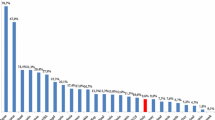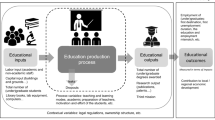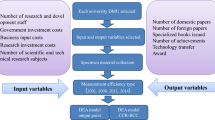Abstract
This paper examines the performance of Thai public universities in terms of efficiency, using a non-parametric approach called data envelopment analysis. Two efficiency models, the teaching efficiency model and the research efficiency model, are developed and the analysis is conducted at the faculty level. Further statistical analyses are also performed to examine the difference in performance between two types of public universities, namely the government universities and the autonomous universities. Then, the differences in efficiency between university locations and types of faculties are examined. The results indicate that the autonomous universities outperform the government universities in terms of research efficiency. In addition, the universities in provincial areas and the faculties in the health science group are efficient in terms of teaching. Recommendations are also provided for the university administrators to improve the performance of public universities in Thailand.
Similar content being viewed by others
References
Abbot, M., & Doucouliagos, C. (2001). Total factor productivity and efficiency in Australian colleges of advanced education. Journal of Educational Administration, 39(4), 384–393.
Abbot, M., & Doucouliagos, C. (2003). The efficiency of Australian universities: A data envelopment analysis. Economics of Education Review, 22(1), 89–97.
Agasisti, T., & Johnes, G. (2008). Heterogeneity and the evaluation of efficiency: The case of Italian universities. Applied Economics. iFirst article. doi:10.1080/00036840701721463.
Ahn, T., Charnes, A., & Cooper, W. W. (1988). Some statistical and DEA evaluations of relative efficiencies of public and private institutions of higher learning. Socio-Economics Planning Science, 22(6), 259–269.
Avkiran, N. K. (2001). Investigating technical and scale efficiencies of Australian universities through data envelopment analysis. Socio-Economic Planning Sciences, 35(1), 57–80.
Bougnol, M., & Dulá, J. H. (2006). Validating DEA as a ranking tool: An application of DEA to assess performance in higher education. Annual Operational Research, 145, 339–365.
Caballero, R., Galache, T., Gómez, T., Molina, J., & Torrico, A. (2004). Budgetary allocations and efficiency in the human resources policy of a university following multiple criteria. Economics of Education Review, 23(1), 67–74.
Carrington, R., Coelli, T., & Prasada Rao, D. S. (2005). The performance of Australian universities: Conceptual issues and preliminary results. Economics Papers, 24(2), 145–163.
Chandarasorn, V. (2002). Strategies for developing autonomous university. Thai Higher Education Review, 1(1), 14–17.
CHE. (2007). Higher education in Thailand. Bangkok: CHE.
CHE. (2008). Comparison of operating budget—Investment budget: Budget year 2004–2008. Bangkok: CHE. Retrieved January 17, 2008, from https://doi.org/www.mua.go.th/users/budget/statistics.html
Cherchye, L., & Abeele, P. V. (2005). A micro analysis of Dutch university research in economics and business management. Research Policy, 34(4), 495–516.
Colbert, A., Levary, R. R., & Shaner, M. C. (2000). Determining relative efficiency of MBA programs using DEA. European Journal of Operational Research, 125(3), 656–669.
Cooper, W. W., Seiford, L. M., & Tone, K. (2006). Introduction to data envelopment analysis and its uses. New York: Springer.
De Lancer Julnes, P. (2000). Decision-making tools for public productivity improvement: A comparison of DEA to cost–benefit and regression analysis. Journal of Public Budgeting, Accounting & Financial Management, 12(4), 625–646.
Fandel, G. (2007). On the performance of universities in north Rhine-Westphalia, Germany government’s redistribution of funds judged using DEA efficiency measures. European Journal of Operational Research, 176(1), 521–533.
Førsund, F. R., & Kalhagen, K. O. (1999). Efficiency and productivity of Norwegian colleges. Memorandum, 11, 1–38.
Glass, J. C., McCallion, G., McKillop, D. G., Rasaratnam, S., & Stringer, K. S. (2006). Implications of variant efficiency measures for policy evaluations in UK higher education. Socio-Economic Planning Sciences, 40(2), 119–142.
Herrero, I., & Pascoe, S. (2002). Estimation of technical efficiency: A review of some of the stochastic frontier and DEA software. Computers in Higher Education Economics Review, 15(1). Retrieved from https://doi.org/www.economics.ltsn.ac.uk/cheer.htm
Johnes, J. (2006). Data envelopment analysis and its application to the measurement of efficiency in higher education. Economics of Education Review, 25(3), 273–288.
Johnes, J., & Johnes, G. (1995). Research funding and performance in UK university departments of economics: A frontier analysis. Economics of Education Review, 14(4), 301–314.
Johnes, J., & Johnes, G. (2009). Higher education institutions’ costs and efficiency: Taking a decomposition a further step. Economics of Education Review, 28(1), 107–113.
Kao, C., & Hung, H. (2008). Efficiency analysis of university departments: An empirical study. Omega, 36(4), 653–664.
Kirtikara, K. (2001). Higher education in Thailand and the national reform roadmap. Retrieved May 30, 2008, from https://doi.org/www.kmutt.ac.th/pi/backup/fileKK/Higher%20Edu%20Reform%20Roadmap.pdf
Kirtikara, K. (2004). Transition from a university under the bureaucratic system to an autonomous university: Reflections on concepts and experience of King Mongkut’s University of Technology Thonburi. Bangkok: Office of Education Council, Ministry of Education.
Korhonen, P., Tainio, R., & Wallenius, J. (2001). Value efficiency analysis of academic research. European Journal of Operational Research, 130(1), 121–132.
Kuo, J. S., & Ho, Y. C. (2008). The cost efficiency impact of the university operation fund on public universities in Taiwan. Economics of Education Review, 27(5), 603–612.
Kuo, J. S., Kuo, C. S., & Ho, Y. C. (2005). Relative efficiencies of public and private institutions of learning in Taiwan. Paper presented at the annual meeting of the Public Choice Society, San Antonio, TX, USA.
Mensah, Y. M., & Werner, R. (2003). Cost efficiency and financial flexibility in institutions of higher education. Journal of Accounting and Public Policy, 22(4), 293–323.
Moreno, A. A., & Tadepalli, R. (2002). Assessing academic department efficiency at a public university. Managerial and Decisions Economics, 23(7), 385–393.
NESDB. (2003). The study project of Thailand’s competitiveness Book 1: Macroeconomics study. Bangkok: Office of the NESDB. Retrieved May 30, 2008, from https://doi.org/www.nesdb.go.th/Portals/0/tasks/dec_ability/report/data16_18.zip
OEC. (2003). Strategies and road map for higher education reform in Thailand. Bangkok: OEC.
Robst, J. (1997). Cost efficiency in public higher education. Retrieved April 11, 2009, from https://doi.org/www.eric.ed.gov/ERICDocs/data/ericdocs2sql/content_storage_01/0000019b/80/15/bd/d7.pdf
Salerno, C. S. (2003). What we know about the efficiency of higher education institutions: The best evidence. Retrieved April 11, 2009, from https://doi.org/www.minocw.nl/documenten/bhw-99-bgo99.pdf
Sangnapaboworn, W. (2003). Higher education reform in Thailand: Towards quality improvement and university autonomy. Paper presented at the 8th Shizuoka Asia-Pacific Forum on Approaches to Higher Education, Intellectual Creativity, Cultivation of Human Resources seen in Asian Countries, Shizuoka, Japan.
Sarrico, C. S., & Dyson, R. G. (2000). Using DEA for planning in UK universities—An institutional perspective. Journal of the Operational Research Society, 51(7), 789–800.
Sherman, H. D., & Zhu, J. (2006). Service productivity management: Improving service performance using Data Envelopment Analysis (DEA). New York: Springer.
Sinuany-Stern, Z., Mehres, A., & Barboy, A. (1994). Academic departments efficiency via DEA. Computers Operations Research, 21(5), 543–556.
Stevens, P. A. (2005). A stochastic frontier analysis of English and Welsh universities. Education Economics, 13(4), 355–374.
Warning, S. (2004). Performance differences in German higher education: Empirical analysis of strategic groups. Review of Industrial Organization, 24(4), 393–408.
Author information
Authors and Affiliations
Corresponding author
Rights and permissions
About this article
Cite this article
Kantabutra, S., Tang, J.C.S. Efficiency Analysis of Public Universities in Thailand. Tert Educ Manag 16, 15–33 (2010). https://doi.org/10.1080/13583881003629798
Published:
Issue Date:
DOI: https://doi.org/10.1080/13583881003629798




